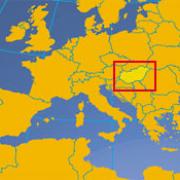
Hungary is a small but beautiful Central European country which has a rich and diverse history, writes Broughton resident Bori Godley, but few realise it has links to Scotland stretching back centuries.
Born to a Hungarian mother and a Scottish father, I have very close links to both countries. I speak Hungarian fluently, which is often envied by people who know that it’s one of the most difficult languages in the world to learn. I keep in contact with friends and family there, and it’s one of my favourite places in the world. In my opinion, it is unfairly underrated – it has great cultural diversity, a friendly culture and beautiful architecture.
[img_assist|nid=2289|title=|desc=|link=node|align=right|width=162|height=200]There have been Hungarians in Edinburgh for many centuries: the most famous of whom was St Margaret, the Hungarian-born Queen of Scotland who lived in the 11th century.
She was born in 1045, in exile in Hungary after her royal father had fled England due to the Danish conquest. The family returned in 1057, with Margaret's father and brother seen as possible successors to the throne of her great-uncle, King Edward the Confessor. In fact it was Harold Godwinson who succeeded, but after the Battle of Hastings Margaret's family fled north to Northumbria. En route to the Continent, a storm blew their ship northwards, and they ended up seeking shelter with the King of Scotland. The spot where they landed is still famous today and is known as St Margaret’s Hope, near North Queensferry.
Margaret later married King Malcolm III, and went on to live happily in Scotland. She was a greatly respected and popular figure, due to her huge contribution to humanitarian work. She was canonised in 1250 by Pope Innocent IV as a result of her personal holiness, fidelity to the Church and work for religious reform.
[img_assist|nid=2290|title=|desc=|link=node|align=right|width=150|height=200]Since the Reformation, there has been a steady flow of Hungarian Divinity students to the University of Edinburgh. More recently, Lajos Kossuth – the famous lawyer, journalist, politician and Regent-President – fell in love with the country when he came to Scotland in 1856 to give lectures. An example of Hungarian–Scottish exchange but in the opposite direction is Adam Clark (right), who supervised the construction of the famous chain bridge in Budapest in 1849 – the city's first ever permanent crossing.
Immigration increased before and after the Second World War, with Jewish Hungarians moving here because of persecution. There was also a significant increase after the 1956 Uprising, when – during a few, short months of instability – many came to Scotland to avoid communist repression.
[img_assist|nid=2291|title=|desc=|link=node|align=right|width=200|height=133]However, before Hungary’s entry into the European Community in 2004, there were still only about 50 Hungarians in Edinburgh – mostly professionals and PhD students. That number has significantly increased since, with the 2009 Census showing that there are 25,000 Hungarian-born people living in the UK, compared to just 13,159 in 2001.
Hungarians flooded over in a similar way to the Poles, but their community is far less cohesive and visible. The primary reason is the fact that Hungary is only a quarter the size of Poland, but another relates back to the Second World War when Poland had an émigré government in Great Britain which gave support to refugees. This resulted in a multi-generational Polish community, which has been the base for more immigrants ever since.
Furthermore, Polish people are traditionally strict Catholics, and so tend to meet and form a community at church. Hungarians are much more secular. There is a Hungarian Embassy in London, but no consulate in Edinburgh, no delis here, no reading or cultural groups, special masses or self-help/advice centres.
[img_assist|nid=2292|title=|desc=|link=node|align=right|width=200|height=149]The only event that brings Scottish Hungarians together is the Hungarian National Day Festive Lunch, which was last held in Aberdeen on 15 March. Traditional Hungarian food is usually served: goulash soup accompanied by sandwiches, and Hungarian scones.
So what is Scotland like for a Hungarian settler? Betty Kertész moved to Edinburgh 4 years ago and works as a babysitter and cleaner. On first arriving, she says that it was not difficult at all to settle in, because everybody was so welcoming.
‘There are many differences between Edinburgh and Hungary,’ she reveals. ‘Hungarians are harder workers, but people here love life.’
Zsuzsanna Varga arrived 20 years ago, and is a lecturer at Glasgow University. She says: ‘When I first came to Edinburgh, it was less cosmopolitan, less lively. But it has changed spectacularly – people have learnt to embrace newcomers, new smells, new tastes and new flavours’.
Personally, I love being a Scottish Hungarian. I get the benefit of being bilingual, and having two extremely rich cultures to enjoy!
[Find out more here and here.]
[img_assist|nid=2316|title=|desc=|link=node|align=left|width=167|height=200]